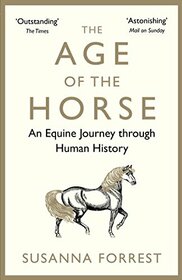Helpful Score: 1
Interesting topic and much enlightening detail, but goes on at too much length about the author's adventures writing the book.
From the school of the "long form essay," beloved of magazines like The New Yorker, where an interesting topic takes back seat to the minutiae of the essayist's journey. The author, or the author's publisher, or a grant-giving body has paid good money to ship the author the exotic places to "experience" first hand some of the issues covered in the book, and by God we are going to hear all about the full experience, in gruesome detail.
Chapter 4 begins with a classic of the "art" (sarcasm), where Forrest walks through the seemingly deserted écuries, or stables, of Versailles, and describes every single things she sees: "A full bottle of red wine, opened and recorked. A box of instant noodles. A thick quilted saddle pad on a radiator ..." Every ... single ... thing ... for four pages. Four pages, without even a glimpse of a horse, just an insight into the poor housekeeping of the staff at the Grande and Petite Ãcuries. No idea how that's supposed to enlighten me, as a seeker of wisdom about horses.
I liked Forrest's decision to organize her material into eight topics that reflect the ways that we have "shaped" the horse, and the horse has shaped us. And I did learn a lot -- I just felt that I had to wade through a lot of unnecessary "local colour," the written equivalent of sharing your holiday snaps, to do it.
From the school of the "long form essay," beloved of magazines like The New Yorker, where an interesting topic takes back seat to the minutiae of the essayist's journey. The author, or the author's publisher, or a grant-giving body has paid good money to ship the author the exotic places to "experience" first hand some of the issues covered in the book, and by God we are going to hear all about the full experience, in gruesome detail.
Chapter 4 begins with a classic of the "art" (sarcasm), where Forrest walks through the seemingly deserted écuries, or stables, of Versailles, and describes every single things she sees: "A full bottle of red wine, opened and recorked. A box of instant noodles. A thick quilted saddle pad on a radiator ..." Every ... single ... thing ... for four pages. Four pages, without even a glimpse of a horse, just an insight into the poor housekeeping of the staff at the Grande and Petite Ãcuries. No idea how that's supposed to enlighten me, as a seeker of wisdom about horses.
I liked Forrest's decision to organize her material into eight topics that reflect the ways that we have "shaped" the horse, and the horse has shaped us. And I did learn a lot -- I just felt that I had to wade through a lot of unnecessary "local colour," the written equivalent of sharing your holiday snaps, to do it.




